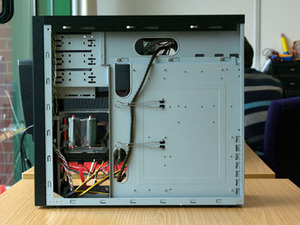Testing Grounds
Ah, finally we reach the testing grounds – and it is here where so many PC cases fail. It doesn’t matter how nice they look or how sturdy the construction is. It can have the biggest HDD rack in the universe, but if the system inside is bought to a stuttery, grinding halt in the thermal performance tests then the case as a whole falls flat on it’s face.In order to make sure that our testing method is reliable and consistent, we make sure to always use the same hardware and the same method every single time. We’re also completely open about our testing methods and encourage readers to let us know if they have any doubts or questions about our process.
So, here we go.
There are three things we look for in each and every case we review and it doesn’t matter if the chassis in question is made of plastic and built for mATX motherboards or sculpted from chocolate and designed to house a E-ATX system.
The first thing we look for is a case which is easy to work with. As we mentioned before, we’re forever diving in and out of these systems and tweaking the hardware, so having a case which we can work well with is very important. To test this we install a system in it and to make sure that this test is reliable we use the same system everytime. Find the specification for it below.
CPU: Intel Pentium XE 955 (dual-core, 3.46GHz)
Graphics Card: Sapphire Radeon X1600 XT Ultimate
Motherboard: MSI P6N SLI Platinum
RAM: 2x 512MB Corsair XMS2-667
Hard Drive: 1x 250GB Western Digital WD2500 7,200RPM
Heatsink: Asus Silent Square Pro
Sure, that system isn’t exactly cutting edge, but that fact plays to our advantage in thermal performance test which comes next. In this test we want to make sure that the case is keeping our components cool – to get too hot is to die!
Our thermal testing is multi-layered to ensure that it is as comprehensive as possible. We start things off by testing the temperature of the system when it is running completely idle, with nothing but the desktop. After that we run a CPU/RAM stress test which heats things up a notch. Finally, after the system has cooled off a bit, we run a GPU stress test using 3DMark.
Throughout all these tests we monitor the temperature of the CPU, the GPU, the interior temperature of the case and the ambient temperature. Comparing these figures against the ambient won’t give you a sure-fire indication of system performance, but it should provide a good indication.
The final test we subject all cases to is a noise evaluation test, where we judge how noisy the case gets compared to other machines we’ve worked with. This test is the most subjective of all as we don’t have access to the equipment needed to test how much noise the case makes objectively. To do that would require us to have soundproof rooms for starters and, while the little cubbyhole Jamie sits in is good, it isn’t that good.
So, now you know the how and why of our testing methodology – all that’s left now is to get on to the results!

MSI MPG Velox 100R Chassis Review
October 14 2021 | 15:04













Want to comment? Please log in.